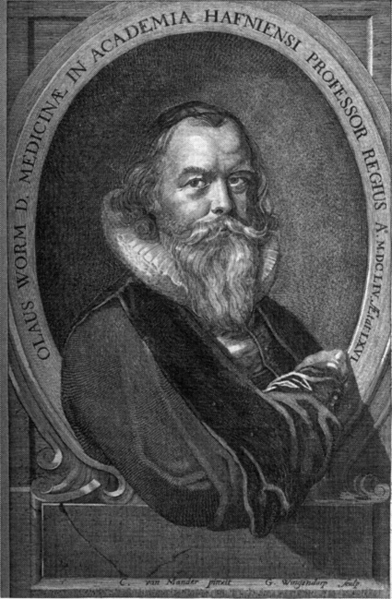<Back to Index>
- Physician Ole Worm, 1588
- Photographer Peter Henry Emerson, 1856
- Empress Consort of the Holy Roman Empire Maria Theresa Walburga Amalia Christina, 1717
PAGE SPONSOR

Ole Worm (pronounced "Olə Vorm") (May 13, 1588 – August 31, 1655), who often went by the Latinized form of his name Olaus Wormius, was a Danish physician and antiquary.
Worm was the son of Willum Worm who served as the mayor of Aarhus, and was made a rich man by the inheritance from his father. Ole Worm's grandfather Johan Worm, a magistrate in Aarhus, was a Lutheran who had fled from Arnhem in Gelderland while it was under Catholic rule. He married Dorothea Fincke, the daughter of a friend and colleague, Thomas Fincke, a mathematician who invented the terms 'tangent' and 'secant'.
Ole Worm was something of a perpetual student: after attending the grammar school of Aarhus, he continued his education at the University of Marburg in 1605, received his Doctor of Medicine degree from the University of Basel in 1611, and received a Master of Arts degree from the University of Copenhagen in 1617. The rest of his academic career was spent in Copenhagen, where he taught Latin, Greek, physics, and medicine. He was personal physician to King Christian IV of Denmark. Somewhat remarkable for a physician of the time, he remained in the city of Copenhagen to minister to the sick during an epidemic of the Black Death. In medicine, Worm's chief contributions were in embryology. The Wormian bones (small bones that fill gaps in the cranial sutures) are named after him. Worm is also known to have been a collector of early literature in the Scandinavian languages. He also wrote a number of treatises on runestones and collected texts that were written in runic. Worm received letters of introduction to the bishops of Denmark and Norway from the King of Denmark due to the King's interest and approval. In 1626 Worm published his Fasti Danici, or "Danish Chronology," containing the results of his researches into runic lore; and in 1636 Runir seu Danica literatura antiquissima, "Runes: the oldest Danish literature," a compilation of transcribed runic texts. In 1643 his Danicorum Monumentorum "Danish
Monuments" was published. The first written study of runestones, it is
also one of the only surviving sources for depictions of numerous
runestones and inscriptions from Denmark, some of which are now lost. As a natural philosopher, Worm assembled a great collection of curiosities, which ranged from native artifacts collected from the New World, to taxidermed animals, to fossils,
on which he speculated greatly. Worm compiled engravings of his
collection, along with his speculations about their meaning, into a
catalog of his Museum Wormianum, published after his death, in
1655. As a scientist, Worm straddled the line between modern and
pre-modern. As an example, in a very modern, empirical mode, Worm determined that the unicorn did not exist and that purported unicorn horns were really simply from the narwhal.
At the same time, however, he then wondered if the anti-poison
properties associated with a unicorn's horn still held true, and
undertook experiments in poisoning pets and then serving them ground up
narwhal horn (his poisoning must have been relatively mild because he
reported that they did recover). His other empirical investigations included providing convincing evidence that lemmings were rodents and not, as some thought, spontaneously generated by the air, and also by providing the first detailed drawing of a bird of paradise proving
that they did, despite much popular speculation to the opposite, indeed
have feet like regular birds. Worm's primary use of his natural history
collection was for the purpose of pedagogy.
In more recent years, the real Worm (and his various accomplishments) have been supplanted to many by a fictional character with his name. H.P. Lovecraft in a fictional history of his notorious fictional grimoire, the Necronomicon, ascribes the Latin translation to an Olaus Wormius, but misplaces him in the thirteenth century.